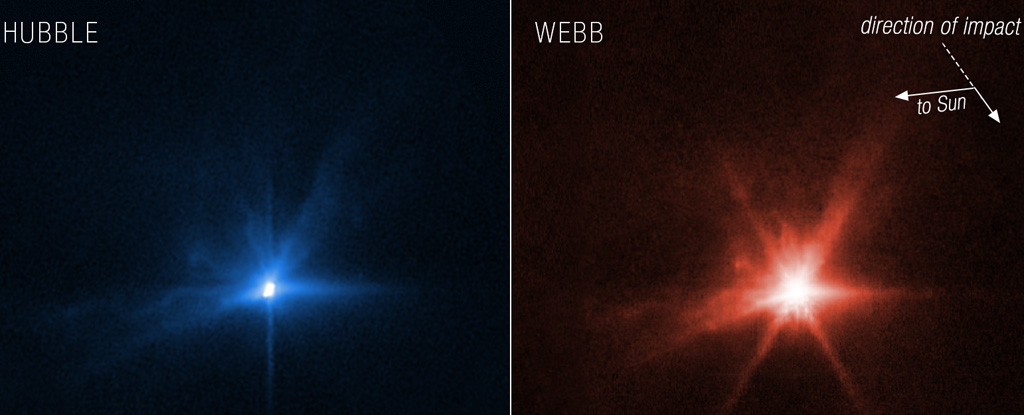James Webb and Hubble on Thursday released their first images of a spacecraft asteroid that deliberately collided, in which astronomers say the impact was much larger than expected.
Earlier this week, global telescopes set their sights on the space rock Demorphos for a historic test of Earth’s ability to fend off potentially life-threatening asteroids in the future.
Astronomers rejoiced Monday night when NASA’s Double Asteroid Redirection Test (DART) collided with a pyramid-sized football target 11 million kilometers (6.8 million miles) from Earth.
Images from ground-based telescopes showed a huge cloud of dust expanding from Demorphos and its older brother Didymus, orbiting around it, after the spacecraft collided.
Alan Fitzsimmons, an astronomer at Queen’s University Belfast who was involved in the Atlas project’s observations, said that while the images showed material sprayed for thousands of kilometers, the James Webb and Hubble images were “very close”.
Fitzsimmons told AFP that James Webb and Hubble could provide “a view of several kilometers from the asteroid, and you can clearly see how the material escapes from this explosive effect of the dart”.
“It’s really amazing,” he said.
According to ESA, James Webb and James Webb and Hubble.
Hubble images 22 minutes, 5 hours and 8 hours after impact show the spread of the droplet at the point of impact of the dart.
worry about what
Ian Carnell of the European Space Agency said Webb and Hubble’s “impressive” images were very similar to those taken by the toaster-sized LICIACube satellite, an asteroid that was in close proximity to DART The spacecraft came just 50 kilometers from the asteroid just a few weeks after separation. . .
The images depicted an impact that appeared to be “much larger than we expected,” said Canelli, the director of the European Space Agency’s Hera mission, which intends to examine the damage within four years.
Canelli told AFP that at first “I was really worried that Demovers would have nothing”.
The Hera mission, scheduled to launch in October 2024 and reach the asteroid in 2026, is expected to survey a crater about 10 meters (33 feet) in diameter.
Now it appears to be bigger, Canelli said, “if there was a pit, a piece of demofex might have just been cut off.”
The real measure of DART’s success will be how much the asteroid’s path has been altered so the world can begin to prepare to protect itself from larger asteroids that may head towards us in the future.
It could take at least a week for Earth-connected telescopes and radars to get an initial estimate of how much the asteroid’s orbit has changed, and three to four weeks to make accurate measurements, Carneli said.
big influence
“I expected the deviation to be much larger than we planned,” he said.
This will “have huge implications for planetary defenses, because it means the technology can be used on larger asteroids,” added Canelli.
“Until today, we thought the only way to deviate was to launch a nuclear bomb.”
Even if Dimorphos hadn’t been “ejected,” Fitzsimmons said, DART’s impact on its orbit would still be minimal.
“But the higher the material, the faster it moves, the greater the deflection,” he said.
Observations by James Webb and Hubble will help reveal the amount and velocity of material ejected from the asteroid, as well as the properties of its surface.
The asteroid impact is the first time two space telescopes have observed the same object.
Since launching in December and releasing the first images in July, James Webb has earned the title of Hubble’s most powerful space telescope.
The images are “a great demonstration of the additional science that can be gained by using more than one telescope at a time,” Fitzsimmons said.
© AFP
